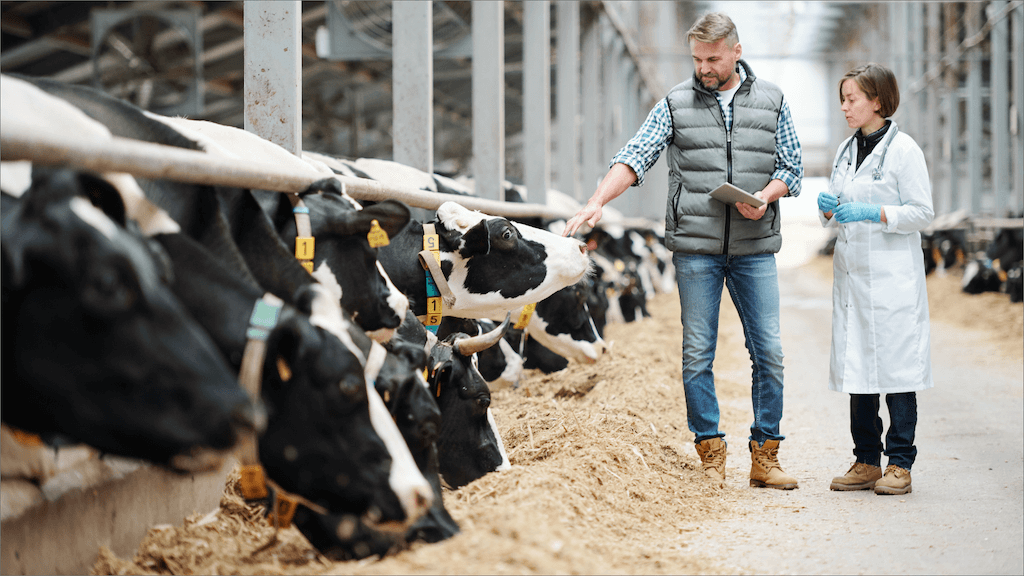Category: AgriFood
MaxinAI solution helped an Ireland-based customer automate livestock monitoring and tracking – improving farm operational efficiency and ultimately reducing costs.
Challenge
Agriculture is an ancient activity that researchers believe was “invented” around 12,000 years ago and has been present in daily human life ever since.
Despite the fact that this sector is one of the leading occupations among the population in the countryside, it still lags behind other sectors in terms of underdeveloped methodologies and the use of obsolete techniques. More specifically, there is a demand for safer and more effective operations within this sector.
Innovative solutions such as artificial intelligence, machine learning and computer vision have penetrated many sectors and demonstrated the untapped potential that can be achieved within the agricultural sector in terms of improving operational efficiency.
Fortunately, more and more farms are starting to follow this positive trend. One of them is our client from Ireland that wanted to improve the operational and financial efficiency of its farm.
What is computer vision?
Let’s start with the definition of computer vision, which is defined as the extraction and analysis of information from images or videos to be used in applications such as robotics, security systems and self-driving cars.
Computer vision has several applications within large industrial areas such as manufacturing, surveillance and even medicine.
An application that we will focus on is the use of computer vision in the agricultural sector, which has many benefits such as crop yield, cost and energy reduction.
Solution


Our solution is based on computer vision and acquires data on livestock from cameras installed in the facility. With the help of cameras, images and videos are automatically analyzed and meaningful insights are gained, without the need for human intervention.
The solution recognizes and counts the livestock, as well as their activities such as how long the cattle are being milked. Livestock detection and recognition helps farms operate more efficiently for higher productivity and lower costs by controlling animal diseases and tracking livestock to ensure their safety.
In addition to livestock, the activities of human personnel are also being tracked and analyzed. The system also shows exactly when activities were carried out so that operations can be adjusted and changed according to the need. In this way, users can obtain details about cows that were previously difficult to identify, such as the reason for their illness and body condition.
Another reason users get better and more accurate information on the condition of cattle is that in the presence of a human, cows have evolved to hide most of the early signs of lameness. In many cases, cows can go on for weeks with hurting legs before showing obvious signs of limping. The delay in injury identification negatively affects food intake, milk production, fertility, and longevity.
However, when the injury becomes apparent, most of the time the damage worsens and the cow’s productivity is hampered for a considerable period of time. This can have catastrophic consequences for a farmer if it happens to several animals at the same time.
The advantage of our solution is that when cows are being monitored with smart cameras, they do not feel the human presence and their actions are not disguised, giving more genuine information about their health.
With our solution, the client was able to prevent the aforementioned incidents and optimize various operations such as energy savings, human resources savings and other costs, achieving the advantages of high efficiency and high precision.


Technologies:
- PyTorch
- Python
- Deep learning
- Computer vision algorithms
Time for a change
The opportunities are limitless when it comes to artificial intelligence in the agricultural industry. Replacing manual labor with automation, whenever possible, is important for reducing costs and improving productivity. However, it becomes especially important for farms, as livestock is an essential and significant part of the agricultural sector and the removal of the human factor can contribute to the early identification of injuries in livestock.
If you are a representative of the agricultural sector and you are interested in a similar solution, do not hesitate and schedule a call with our expert.
We will go over your specific use case and offer you a pilot project free of charge!
Drones are a hot topic these days. But what if these aerial vehicles were actually delivering more than just nice videos? What if they could help farmers ensure successful harvests and safer food supplies, too?
Actually, they can — and the agricultural industry is taking notice. Drones help the agricultural industry by increasing crop production and monitoring crop growth.
Who would have thought that drones, a tool originally built for military purposes, would come in handy for many industries? For some sectors such as agriculture, it has become so useful that it can help to carry out activities that could not have been done before.
In fact, agriculture is one of these sectors that is constantly looking for innovative solutions, as the population is expected to reach 9.1 billion by 2050 and the industry faces the challenge of boosting food production that meets the growing demand.
To overcome the challenges, more attention began to be paid to drones equipped with computer vision technology to help increase crop yields. These technologies have become so popular with the industry that they are projected to grow 5x and be worth $ 5.7 billion by 2025.
So what exactly do these unpiloted aircrafts offer to farmers?
AI-powered drones


Modern irrigation practices, livestock technology, fertilizer management, and various other tools have allowed farmers to improve different operations. But when it comes to crop production and growth monitoring, drones have established themselves as the best solution for farmers.
The drones are equipped with GPS systems and cameras that allow them to fly over every part of the field that needs to be inspected and take images. So once the crops have been planted and started to grow, farmers implement this technology and give a certain flight path based on the area they want to survey.
So what’s new and innovative in flying camera drones? Well, the thing is, these cameras are not the normal ones. They are called multispectral imaging cameras that are so comprehensive that they are used for military purposes such as detecting landmines.
While landmine detection is useful for everyone, for farmers it is primarily used to improve crop, soil and fertilization management. The taken images are integrated with specific software that shows the image in different colors. For example, if the field shows green color, the crops in that area have good photosynthesis and their growth is healthy.


However, the areas showing the red and yellow color need attention, as the crops are not growing as they should. All of this information is vital as after looking at it, farmers can manually go and check what is causing the problem of unhealthy crops. Are the crops underwatered, insufficiently fed, are insects causing the issue or perhaps the plants are being overwatered?
This allows farmers to be proactive rather than reactive when the problem is already visible and damaging. The ability to be proactive is due to drones that make the crop monitoring process fast and effective.
Imagine farms of over a thousand acres. The human resource it would take to replace what drones effortlessly do would be immense. With flying technology, however, they not only save time but detect details that would be impossible to see with the naked eye, regardless of human resources.
Innovating the farming industry
Drones serve as a powerful tool to monitor the growth of crops. But this is not the only thing that these flying objects can help farmers with. In addition to supervision, they can also plant seeds, apply spray treatments, and even serve as a security tool to keep an eye on the area and make sure operations are going as planned.
With so many applications and benefits, it is not an enigma why this technology is experiencing such rapid growth and why so many farms are turning their attention to drones.
If you want to keep up with the trend using the technology described above or any other, you have come to the right place. Our experts offer a free consultation call to discuss your ideas and their tangibility.
Snap a picture of a gas certificate or other property doc and automatically convert it into renewal reminders and key data using ExtractHD. Saves time, saves money.















